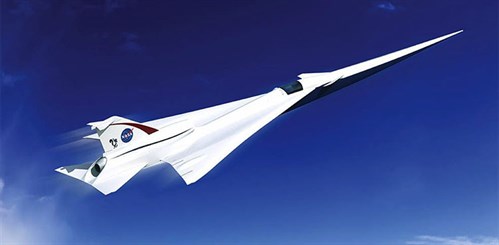 One of the main reasons you don’t see supersonic jets flying across the country is noise. Sonic booms created by supersonic flight were so disruptive that the Federal Aviation Administration (FAA) and Congress banned supersonic travel over the United States in 1973. A multi-disciplinary team headed up by principal investigators (PIs) in the Department of Aerospace Engineering at Texas A&M University and Boeing Research & Technology (BR&T) hopes to solve this problem.
One of the main reasons you don’t see supersonic jets flying across the country is noise. Sonic booms created by supersonic flight were so disruptive that the Federal Aviation Administration (FAA) and Congress banned supersonic travel over the United States in 1973. A multi-disciplinary team headed up by principal investigators (PIs) in the Department of Aerospace Engineering at Texas A&M University and Boeing Research & Technology (BR&T) hopes to solve this problem.
NASA has selected the team for a five-year, $10 million grant as part of NASA Aeronautics’ University Leadership Initiative (ULI). The team will lead research into designing commercially-viable civil supersonic transport (SST) aircraft that can modify shape during flight under a range of conditions to meet noise and efficiency requirements for overland flight.
Supersonic aircraft capable of flying faster than the speed of sound (Mach 1) were developed in the 20th century and used mainly for military purposes. Only two SSTs were used for commercial flight, the Tupolev Tu-144 and more notably, the Concorde. The Concorde flew commercially from 1976-2003, limited to transatlantic travel between New York City, London, Paris and Washington, D.C., because of the FAA ban on overland flight.
With advances in technology and modern engineering, there is a renewed interest in supersonic aircraft for commercial flight. Reducing the sound of the sonic boom created by the SSTs could be the catalyst for the FAA to lift the ban on overland flight.
To be commercially viable, an SST must meet boom noise limits for a range of flight conditions, and thus requires the ability to adapt at a moment’s notice. The ULI research team will explore the potential of small real-time geometric reconfigurations on the outer mold line (OML) of the aircraft to minimize boom signatures and drag in response to those changing conditions.
The team will combine improved supersonic computational fluid dynamic (CFD) methods, boom propagation models and new atmospheric sensing techniques into a new multi-disciplinary design framework. They will focus on determining if embedding shape memory alloy (SMA) actuators will provide solutions for in-flight adjustments of an SST aircraft from takeoff to landing. The goal is to enable optimal low boom and low drag configurations across all environments.
New tools will be developed to explore what kinds of small-scale adaptations can truly affect SST flight performance. A detailed study will determine whether SMA materials with the appropriate temperature and force/displacement characteristic exist and whether SMA-based actuators are economically viable at the system level.
The overall research strategy is to pursue three critical areas: the design of configurations for reducing boom, material development and modeling, and technology feasibility demonstration in a relevant environment.
With Texas A&M as the lead institution, the management of the project will be performed by Dr. Dimitri Lagoudas, deputy director of the Texas A&M Engineering Experiment Station, with the help of Dr. Darren Hartl as the operations director. Co-PIs include Dr. Paul Paul Cizmas and Dr. Rodney Bowersox from the Department of Aerospace Engineering, along with James Mabe (BR&T).
Other members from Texas A&M include Dr. Helen Reed (aerospace engineering), Dr. Richard Miles (aerospace and mechanical engineering), Dr. Richard Malak (mechanical engineering) and Dr. Ibrahim Karaman (materials science and engineering). Rounding out the team are Dr. George Dulikravich, Department of Mechanical and Materials Engineering, Florida International University; Dr. Theocharis Baxevanis, Department of Mechanical Engineering, University of Houston; Dr. Marcus Young, Department of Materials Science and Engineering, University of North Texas; Dr. Doug Hunsaker, Department of Mechanical and Aerospace Engineering, Utah State University; Dr. Eric Blades, ATA Engineering; Edward White, Boeing; Todd Magee, Boeing; David Lazzara, Boeing; Hao Shen, Boeing; Dr. Jeremy Schaffer, Fort Wayne Metals.
Lagoudas, Karaman and Hartl have collaborated with Boeing on the development of SMA alloys and actuators for conventional subsonic applications for over a decade with great success. Bowersox, Miles and Reed participated in the Defense Advanced Research Projects Agency (DARPA) Quiet Supersonic Platform program, which was focused on sonic boom mitigation. This project brings these two technological challenges together to provide creative solutions to enable supersonic flight.
The academic institutions will lead the engineering science aspects of the research, transferring new technological capabilities to the industrial partners. These partners, with a background in successful development and deployment of novel shape memory and supersonic applications, will provide guidance regarding real-world requirements. Industry partners will form the nucleus of an industry advisory board and will evaluate technology commercialization paths from the research outcomes.
Students from the six participating academic institutions will have the opportunity to gain valuable research experience from world leaders in supersonic platform design, and active materials and adaptive structures development. Miles and Reed will be critical in promoting collaborative research and novel education opportunities for students and post-docs through the interchange of students among the institutions.